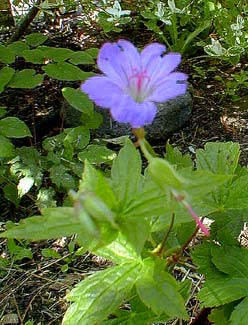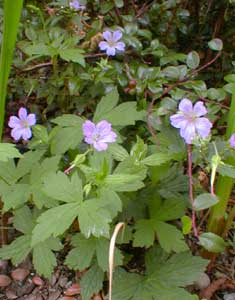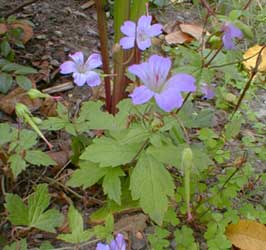
Knotted Crane's-bill
"Dew-laden hillsides
'neath overcast skies;
Bent grass, blue cranesbills,
& dawn's golden rise."
"Morning Fragment"
paghat,
autumn 2003
Our Crane's-bill collection has grown so much, there are hardy geraniums filling many spaces, under & between things. After a while many of them begin to look rather similar for leaf & flower, so that by now we are usually looking for types that have something about them that's truly a bit different.
A native of the Pyranees, Geranium nodosum stood out due to the fact that it had leaves different from the usual two leaf types (either deeply cut, or scalloped). This one has shiny green leaves that look similar to maple leaves or highbush cranberry.
 The flowers themselves are basic Crane's-bill lavender to lilac-pink, with darker rose-pink lines, & a pearlesent sheen.
The flowers themselves are basic Crane's-bill lavender to lilac-pink, with darker rose-pink lines, & a pearlesent sheen.Ours is the wild species rather than a named cultivar, so it blooms a bit less floriferously than cultivars selected & bred for maximum number of flowers. But the flowers it does produce are exceedlingly long-lasting.
The photos on this page were taken consecutively in June, July, & October. It blooms sporadically for as long as from May to November, in chillier climates than ours this would be shortened to a still impressive length of time from June until after the first couple frosts of Autumn.
For the coast, it blooms best in full morning or full afternoon sunlight, with moderate but not too much watering. It will also do fairly well in a shady woodland setting, which is the environment ours is experiencing. When grown in a shadier spot, it grows more upright, a foot to twenty inch mound of dense greenery; in sun it is almost a creeper.
It is even slightly adaptable to dryish shade, dry shade having fewer plant choices, but this possibility can't be taken too far as it will look crappy if it experiences too many droughty days. Originally I placed it in a location that got afternoon sun & not too much watering. This proved a poor choice, as while moist to moderately dry shade suits it, & moister soil in bright sun suits it, sun & dryness together pushed its tolerances much too far.
 Seeing that it was suffering, I transplanted it to a well-irrigated location shadowed by a cherry tree & evergreen huckleberries. Its misery for having first been planted in an unfavorable location, then suddenly transplanted, exhausted the tragic clump & caused its leaves to wither to the ground. I thought perhaps I had killed it due to my first carelessly chosen location.
Seeing that it was suffering, I transplanted it to a well-irrigated location shadowed by a cherry tree & evergreen huckleberries. Its misery for having first been planted in an unfavorable location, then suddenly transplanted, exhausted the tragic clump & caused its leaves to wither to the ground. I thought perhaps I had killed it due to my first carelessly chosen location.Uncertain if I would ever see it again, I even forgot where I'd moved it to, until a very few weeks later there it was very fluffily leafed out & in full flower in the midst of a hot July (2003), so I snapped its picture (the second photo on this page). It had proven indeed a hardy survivor! It was still in flower in November, then went dormant until spring, back in bloom again the following May, with light intermittant flowering until October.
This species can self-seed but not too aggressively. New plants can be helped along under a coldframe to get them started. To collect seeds, tie a baggy around the seedheads until the seeds "explode" inside the bag. It is also easily propagated by division every third year or so.